Abstract
Fractal theory is a key part of not only synergetics – it has successfully integrated into a number of humanitarian sciences including linguistic studies. The concept of fractal was first introduced by the mathematician Felix Hausdorff, but the term we use today was coined by Benoit B. Mandelbrot, another outstanding mathematician and polymath. In the following article, the notion of fractal set is specified to the study of open systems which, unlike abstract mathematical structures, are continuously changing and developing under the influence of internal and external fluctuations. The article presents a brief review of how fractal theory has been successfully applied to analyse various kinds of discourse: literary postmodernist, fairy-tale, poetic, pedagogical and filmic, all of which are analysed with the help of a new, semiotic-synergetic approach. The latter relies on the achievements of philosophy, semiotics, synergetics and linguistics and aims at a more thorough research of semantic and structural peculiarities of discourse organisation.
Keywords: Semioticssynergeticsself-organisationfractal setdiscourse
Introduction
Mathematical and stochastic fractal sets
As a matter of fact, the term “fractal” (Latin
Universal features of fractal sets
Fractals have become not only a relatively new kind of computer art, but they are also found in a variety of literary, visual, music and architecture works, especially those that inexplicably fascinate us with their simplicity and harmony. When employed in an interdisciplinary study, the term “fractal”should be used to refer to objects / systems with the following universal characteristics.
Complex structure. Even at an increasingly small scale, fractal structures do not become simple and linear. In other words, each part of each part, when magnified, will look as complex as the whole object.
Self-similarity. Every fractal part is the same or nearly the same as the whole, so fractals possess the property of self-similarity, many of them – approximately.The reiteration of details or patterns occurs at progressively smaller scales and can continue indefinitely.
Fractal dimension. This mathematical parametermakes it possible for a fractal to be a “gene” of form construction, but not the final form.Fractal dimension is generally expressed by a fraction rather than by a whole number.
Fractal models are employed in research when it is necessary to identify and recreate the patterns of behaviour and the peculiarities of systems development. Such systems are known as “open”. They are a class of cultural semiotic systems of natural origin, and their important properties are openness and the ability to change in the process of interaction with the environment.Open systems are continuously affected by internal and external fluctuations and possess synergetic properties of hierarchy, nonlinearity and instability.Open semiotic systems are more difficult to describe than stable systems with minor changes over a long period of time.
Problem Statement
Discourse studies
The importance of the work is conditioned by the need for further theoretical and practical understanding of linguistic, semiotic and synergetic features of discourse viewed as an open system.
Discourse fractality
The fractality of the semantic organisation of discourse has not been thoroughly studied yet, which also ensures the relevance of this research direction.
Research Questions
-
Can discourse be viewed as an open and self-developing system with the following synergetic properties: hierarchal structure, nonlinear mode of behaviour and changeability?
-
Can different types of discourse be studied with the help of the new semiotic-synergetic approach?
-
Will the study reveal different or similar peculiarities of structural and semantic organisation in different types of discourse?
-
Can fractals be employed to visually represent the peculiarities of discourse self-development and self-organisation?
-
What fractal models can most vividly demonstrate these peculiarities?
Purpose of the Study
The purpose of the research is to make a brief survey of a number of successful attempts to apply fractals to the study of the following kinds of English discourse: literary postmodernist, fairy-tale, poetic, pedagogical and filmic, each with its own semiotic peculiarities.
Research Methods
The fundamental works of Yuri M. Lotman, Alexander V. Voloshinov and VladislavV. Tarasenkohave become the methodological basis for semiotic-synergetic research.
In the doctrine of the semiosphere of Yuri M. Lotman, the space of culture into which heterogeneous semiotic systems are submerged creates conditions for a multi-layered interaction of texts forming certain strata with complex internal relations (Lotman, 2010).
In the concept of Alexander V. Voloshinov, the connection between science and art is established. The deep fundamental laws inherent in works of art can now be adequately described in the language of synergetics (Voloshinov, 2000).
VladislavV. Tarasenkoproposed to use the fractal as a theoretical modelwhich can represent the situation of instability of understanding meanings that change under the influence of discourses and communicative features of situations (Tarasenko, 2017).
These and other important results have laid basis for the practical application of fractal theory in the study of discourse.
Findings
The fractal nature of intertextuality and interdiscursivity of literary postmodernist discourse
In the research of Natalia S. Olizko, postmodernist literary discourse is treated as a developing synergetic system, the organisation of which is carried out through the actualisation of system-forming categories of intertextuality and interdiscursivity. Intertextual and interdiscursive relations are represented using the models of fractal self-organisation. Both semantic and structural fractal analysis of discourse is presented. For the first time, the typology of fractal models is proposed and described. These models are:
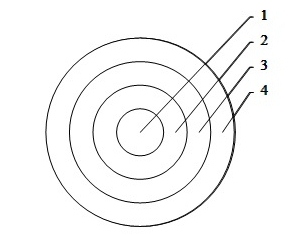
The fractal nature of pedagogical discourse
The material of Maria A. Samkova’s research is English educational and pedagogical discourse which is a complexly organized unity of the process and the result of speech and text formation. Studying the structure-forming features of primary and secondary educational texts as system-forming elements of the educational and pedagogical discourse, the author sees the model of the educational text-polylogue as a
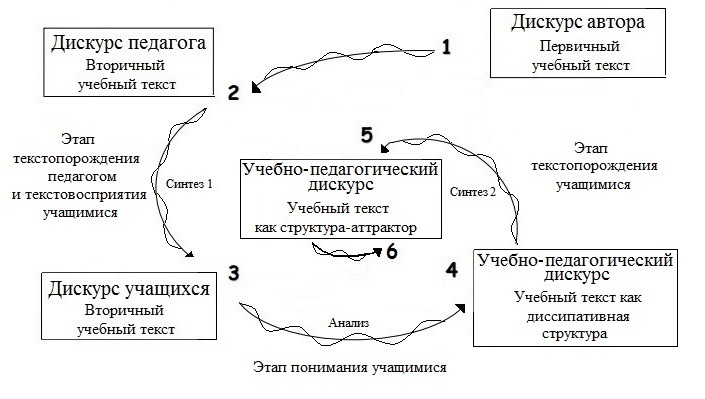
Fractals in fairy-tale discourse
Natalia V. Mamonova operates all the fractal models of discourse self-organisation, which were identifiedand described in the above mentioned works, specifying the
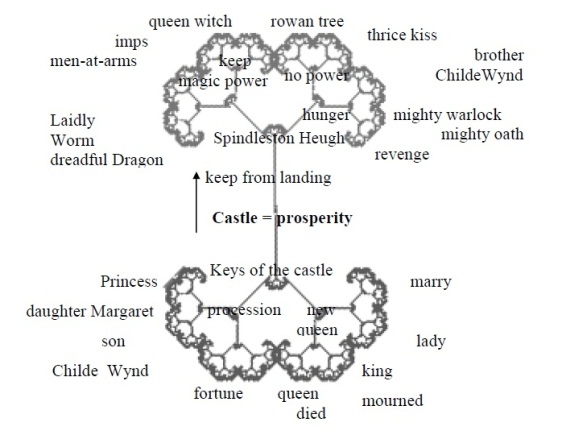
Poetic discourse fractality
In the work of Ilya V. Sergodeyev, the poetic discourse of J. Morrison is also treated as a complex self-organising semioticsystem. The material of this research does not allow the author to speak about any visible structural fractality of the poetic text, therefore he focuses on describing its semantic fractality in the internal (hypertextual) semiotic space and the outer space of semiosphere. Because of its polysemy, the word in the text can become a point of instability. The word can carry information about another text or a lot of texts, greatly expanding the number of variations of its interpretation. The word thus becomes in the mind of the recipient its own enlarged copy: word-text-many texts. It is this point of instability at the time of interpretation of the text that the author represents as a semantic fractal. At each point of instability, under the influence of a chaotic attractor, a set of meanings is generated, but the anti-attractor makes this set finite due to the fact that not every meaning is suitable for the context (Sergodeyev, 2016).
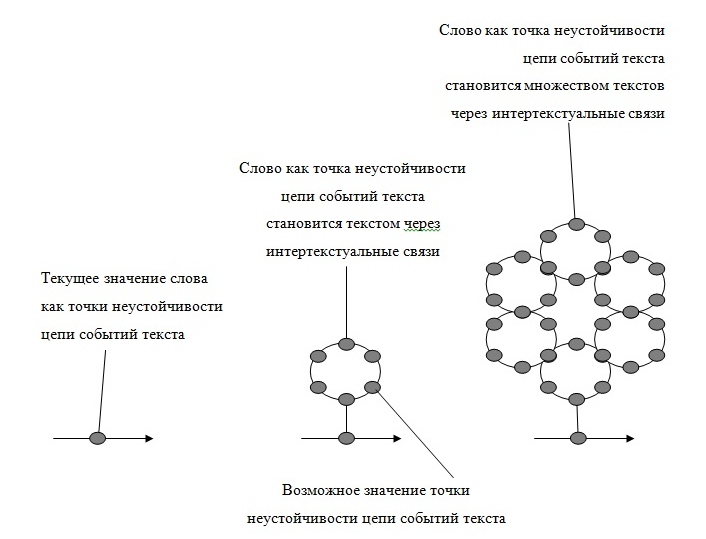
The fractal nature of key concepts in filmic discourse
In our own study, we analyse filmic discourse which is quite different from any other type of discourse as it integrates the widest spectrum of sign systems. Filmic discourse requires a somewhat different approach, and while carrying out its fractal modelling it is important to consider not only verbalisedsemantic elements of the text, but also those that the author expressed though colour, editing, dance, statics, facial expressions, music and other cinematic systems of signs. The results of the analysis of the English-language filmicdiscourse of the historical genre demonstrate the possibility of an adequate description of the features of its semantic and structural self-organisation with the use of universal fractal models of the evolution of systems and their varieties: concentric circles, spiral, tree, rhizome (Zajchenko, 2013).
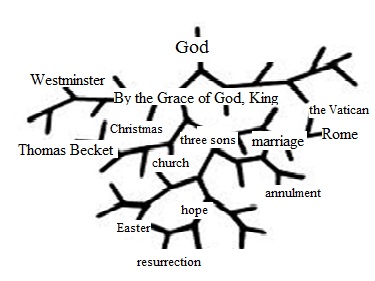
Conclusion
This review therefore shows that fractal theory can besuccessfully applied in the interdisciplinary semiotic-synergetic study of English discourse. Fractal modelling makes visual representation of repetitive self-similar semantic and structural elements of the textpossible;it reveals the processes of their interpenetration and development; helps to recreate non-linear forms of the text, which in totalallows the researcher to penetrate into the deepest meanings of texts and discourses and observe their self-organisation. Fractal modelling of discourse is undoubtedly a promising alternative to research and can be successfully applied to new language material.
References
- Lotman, Yu. M. (2010). Semiosphere. St. Petersburg: Iskusstvo-SPB.
- Mamonova, N. V. (2015). Fractal self-organisation of British fairy-tale discourse. Chelyabinsk: Chelyabinsk State University.
- Olizko, N. S. (2010). Intertextuality and interdiscursivity: Semiotic-synergetic interpretation of system-forming categories of postmodernist literary discourse. Saarbrüсken: LAP LAMBERT Academic Publishing.
- Samkova, M. S. (2014). Linguasynergetic understanding of pedagogical discourse. Chelyabinsk: Chelyabinsk State University.
- Sergodeyev, I. V. (2016). Intertextuality as a means of semantic self-organisation in J. Morrison’s poetry. Chelyabinsk: Chelyabinsk State University.
- Tarasenko, V. V. (2017). Fractal semiotics: “blind spots” and the vicissitudes of understanding. Moscow: Knizhny dom “LIBROKOM”.
- Voloshinov, A. V. (2000). Mathematics and art: a book for those who like not only mathematics or art, but is willing to explore the nature of art and the beauty of sciences. Moscow: Prosveshcheniye.
- Zajchenko, S. S. (2013). Semiotic-synergetic interpretation of English historical filmic discourse organisation. Chelyabinsk: Chelyabinsk State University.
Copyright information

This work is licensed under a Creative Commons Attribution-NonCommercial-NoDerivatives 4.0 International License.
About this article
Publication Date
30 April 2018
Article Doi
eBook ISBN
978-1-80296-038-9
Publisher
Future Academy
Volume
39
Print ISBN (optional)
-
Edition Number
1st Edition
Pages
1-797
Subjects
Sociolinguistics, linguistics, semantics, discourse analysis, translation, interpretation
Cite this article as:
Zajchenko, S. (2018). The Application Of Fractal Theory to The Study Of English Discourse Organisation. In I. V. Denisova (Ed.), Word, Utterance, Text: Cognitive, Pragmatic and Cultural Aspects, vol 39. European Proceedings of Social and Behavioural Sciences (pp. 368-374). Future Academy. https://doi.org/10.15405/epsbs.2018.04.02.53

